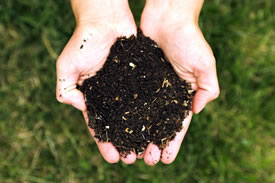Urban composting: Nutrient-rich soil for your garden helps wildlife too

Compost (Photo by Kessner Photography, Wikimedia Commons)
Supporters of the Nature Conservancy of Canada (NCC) are always working towards healthier land and increased biodiversity. And much like me, many people want to know how their daily lives can be friendlier to their environments. Perhaps one of the easiest ways to participate in conservation in your backyard is to compost.
Reducing waste
At first glance, composting may not seem like it contributes to conservation or biodiversity. However, by composting your old food scraps you are reducing the amount of garbage being sent to your local landfill. When there is less space needed by landfills, there is more space left to be used by native flora and fauna!
Reusing food scraps
The most striking benefit of composting is its ability to improve your immediate surroundings. Once you have created high quality soil in your compost bin, you can add it to your lawn, flower pots or — even better — your herbs and vegetables. By reusing nutrients and biomass from your food, you have better yield without having to use fertilizer or lots of topsoil. This saves you money and makes it easier to grow your own food.
Get in touch with nature
Living in the city, sometimes you will seize any opportunity to get your hands dirty (I know I do!). The smell of a well-cared for composter is rich soil, so if you close your eyes you can imagine you’re in a boggy forest. Your compost bin will have its own micro ecosystem, which is fascinating in itself.
How to compost indoors
There are so many online resources to help you determine what style of composting will work best for you. Your compost strategy depends on how many people are using it and what their diets look like. Vermicomposting is better for people with a lot of organic waste because it has a faster decomposition rate. I found that with just me in my household I didn’t require anything other than a couple of small plastic bins.
To start off, drill some holes in the bottom, top and sides of your plastic container for air and moisture to travel through. Place your bin on a tray that can catch any liquid that may drip from the compost. I found the only issue with my compost was excess moisture, so don’t be afraid to drill more holes in the bin if needed at a later time. Start you compost off with a thick base layer made of brown material like newspaper, dried leaves and wood chips. I also added some soil to get things started.
Once you have your base layer made you can start adding green materials such as fruit peels, vegetables, grass clippings and other food scraps (not meat or oil products). They tend to be higher in nitrogen and moisture. The trick is to keep the browns and greens in good balance. I found that I needed more browns because if the compost gets too moist, it will start to smell and attract fruit flies (you only need to have one fruit fly infestation to learn that lesson).
Try layering brown and green and stirring every week or so. You will start to get the sense of what your compost needs after a few weeks.
Indoor composting is a fun and rewarding experience. Managing a small-scale ecosystem inside your home has its challenges but as with any challenge, overcoming it is always worth it. You can feel good about helping to reduce your impact on landfills and you can enjoy even better veggies. You will likely have more fertile soil than you know what to do with.
This just provides another opportunity to spread the joy and teach people about what they can do to help their environment. You can offer your soil to neighbours, friends, family and local community gardens.
Make a difference, every day
I hope this helps to shed some light on how you can make a difference in your environment on a daily basis. Of course although there are many other ways to reduce your impact, I find composting a really rewarding one with many benefits.
Conserving the landscapes of this beautiful country starts with every one of us. Making positive changes to our daily habits and sharing our experiences is a great start!
Feel free to share your indoor composting tips and tricks in the comments below.


